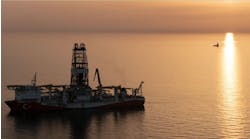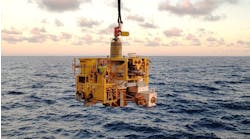Ninety discoveries past the 1,500 ft mark
Marshall DeLucaBusiness Editor
- Deepwater discoveries in the Gulf of Mexico (> 1,500 ft.). [79,408 bytes]
- World record wells. (Courtesy of Global Marine and Offshore Data Services). [30,209 bytes]
- Gulf of Mexico Deepwater Survey [76,780 bytes]
According to the Minerals Management Service (MMS), activity is still continuing at a strong pace. Thirty temporary and permanent deepwater rigs were reported drilling in water depths greater than 1,000 ft in the Gulf of Mexico. This is only a decrease of one rig from the level reported in January.
Three new deepwater records have been established in the past few months:
- Chevron broke the world-record for drilling in the deepest water depths. The Glomar Explorer deepwater drillship drilled a well in Atwater Valley 118 in 7,718 ft of water, surpassing the previous record held by Shell set in 1996 in 7,612 ft.
- EEX also broke records with the Llano prospect in Garden Banks 386. The Llano was drilled to a total depth of 27,864 ft, making it the deepest well in the Gulf of Mexico.
- Shell's Troika well, the second longest tie-back in the Gulf of Mexico, also shattered the US Gulf record for a single-well flow rate. Troika produced 31,000 bbl of oil in one day, eclipsing the 20,500 b/d record set by an Auger well.
Development plans
Several operating companies have announced development plans for deepwater prospects:- Shell has decided to produce three of its fields with subsea tie-backs to existing platforms. Angus (Green Canyon 113) will be tied into the Bullwinkle platform; Europa (Mississippi Canyon 934, 935, 890, and 891) will tie into the Mars TLP; and Macaroni (Garden Banks 602) will tie into the Auger TLP. The three fields hold estimated reserves of more than 300 million BOE.
- Exxon has also decided on a development plan for the Hoover and Diana fields. The company has decided to use a deep draft caisson vessel (DDCV) which will be located over the Hoover discovery in 4,800 ft of water. This will establish a new world water depth record for a drilling and production platform with an associated subsea development. The DDCV will be a catenary-moored steel cylindrical hull designed to handle 100,000 b/d of oil and 325 MMcf/d of gas.
- British-Borneo Exploration has installed the world's first mini-TLP on the Morpeth field (Ewing Bank Block 921) in 1,700 feet of water. The mono-hull TLP was designed and built by Atlantia and installed by J.Ray McDermott. Installation of the facilities on the field were achieved only 18 months after sanction of the project in January 1997. Installation of flexible flowlines and control umbilicals from the subsea wells to the Morpeth SeaStar were also completed, as well as hookup and commissioning of the topsides facilities and commissioning of the export pipeline. First oil was produced in September - in line with the project plan.
- Amerada Hess has also installed the Baldpate compliant tower, the tallest freestanding structure in the world and the first freestanding (non-guyed) offshore tower. The tower was installed in May in Garden Banks 260 in 1,641 ft of water. Baldpate measures 1,902 ft from the seafloor to the tip of the 260-ft flare booms. The structure is capable of handling 60,000 b/d of oil and 200 MMcf/d of gas.
New discoveries
Since January of this year, only four US Gulf discoveries have been made in water depths greater than 1,500 ft, and two more have been made in depths between 1,000 ft and 1,500 ft. Offshore reported eight discoveries had been made in the three-month time frame from the last report, and 22 had been made since January 1997. With only six discoveries made since Jan uary, this is evidence of a discovery slow-down:Deepwater breakdown
Offshore has decided to move up the water depth contour for the term "deepwater". For the past few years, this listing considered deepwater at 1,000 ft, however, with discoveries being made past the 7,000-ft mark, it only seemed logical to up the mark to 1,500 ft.Currently, 90 deepwater discoveries have been announced past this 1,500 ft mark. Sixty-eight of the discoveries have been given pro spect names, 51 of which are in the planning stage. The fact that the fields have been named strongly indicates some sort of development plan for the future.
Thirty-seven discoveries are listed in the 1,500-2,500 ft water depth mark, 20 are between 2,501 ft and 3,500 ft, 18 are between 3,501 ft and 4,500 ft, six between 4,501 ft and 5,500 ft, and nine discoveries have been made in the ultra-deepwater - past the 5,501 ft mark.
The majority of the discoveries (30) have been made in the Mississippi Canyon region. This is followed by Green Canyon (25), Garden Banks (13), and Viosca Knoll (8). Seventy-one of the discoveries are in the planning stage with 19 currently on-production.
Twenty-eight discoveries are between 1,000 ft and 1,500 ft, listed in a separate chart. Twenty-two of these discoveries have been named, 11 of which are on production. Six discoveries remain unnamed, two of which are currently onstream.
Survey explanation
Offshore Magazine's US Gulf Deepwater Survey lists each field by name, location (block number), water depth, operator (partner), stage of development and pro duction type, year of discovery, year of first production, estimated or proven reserves in millions of bbl oil equivalent (BOE), and peak/test production (oil/gas). A dash indicates that the information was un available at press time.Each listing has a number that corresponds to the following map. Numbers on the map in red indicate that the field is in production; numbers in yellow indicate the field is in the planning stage. Fields below the 1,500 ft contour are listed on a separate chart.
Copyright 1998 Oil & Gas Journal. All Rights Reserved.


